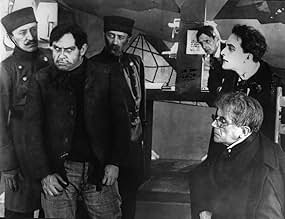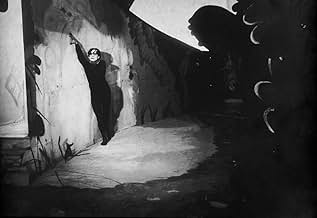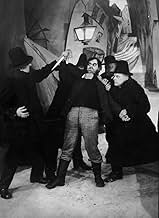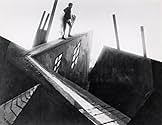CALIFICACIÓN DE IMDb
8.0/10
74 k
TU CALIFICACIÓN
El doctor Caligari, un hipnotista, usa a Cesare, sonámbulo, para cometer asesinatos.El doctor Caligari, un hipnotista, usa a Cesare, sonámbulo, para cometer asesinatos.El doctor Caligari, un hipnotista, usa a Cesare, sonámbulo, para cometer asesinatos.
- Dirección
- Guionistas
- Elenco
- Premios
- 2 premios ganados y 1 nominación en total
Friedrich Feher
- Franzis
- (as Friedrich Fehér)
Hans Heinrich von Twardowski
- Alan
- (as Hans Heinz v. Twardowski)
Rudolf Lettinger
- Dr. Olsen
- (as Rudolph Lettinger)
Rudolf Klein-Rogge
- Ein Verbrecher
- (sin créditos)
- …
Hans Lanser-Ludolff
- Ein Alter Mann
- (sin créditos)
- …
Henri Peters-Arnolds
- Ein Junger Arzt
- (sin créditos)
- …
Ludwig Rex
- Ein Mörder
- (sin créditos)
- …
Elsa Wagner
- Die Wirtin
- (sin créditos)
- …
- Dirección
- Guionistas
- Todo el elenco y el equipo
- Producción, taquilla y más en IMDbPro
Opiniones destacadas
With a story as twisted, buckled and demented as the scenery and set design, and a tortured score to boot, was the lunatic in charge of the asylum? Must have been a moment to remember coming across this cinematic marvel back in 1920. I wonder how many of today's pieces of cinema will stand the test of 100 years, albeit with a lot more competition.
The original message of this film is fairly pedestrian (an outcry against the weak authority in Germany at the time), although the political intrigue surrounding the production led to a fascinating framing story which re-established "the authorities," and in turn made the UFA happy enough to distribute the film. This suggests that in its own time the political message of the film was fairly powerful, but compared to the work done in such films as The Golem, Nosferatu, and Metropolis it is not so far-reaching.
What sets this film apart from its contemporaries is its absolute commitment to the expressionist movement. Mutated sets, heavy dark/light makeup, light and shadow, and a Gothic storyline are classic expressionism. The photography is beautiful and so crisp that it creates an eerie sense that this hellish scene is actually the real world, and that our everyday lives are the delusional Technicolor dream of a madman.
While there are many better movies made in this period, I feel that this one is the pinnacle of the imagery that is characteristic of the expressionist art form. It is an absolute must-see for anyone who is interested in the Expressionist movement.
What sets this film apart from its contemporaries is its absolute commitment to the expressionist movement. Mutated sets, heavy dark/light makeup, light and shadow, and a Gothic storyline are classic expressionism. The photography is beautiful and so crisp that it creates an eerie sense that this hellish scene is actually the real world, and that our everyday lives are the delusional Technicolor dream of a madman.
While there are many better movies made in this period, I feel that this one is the pinnacle of the imagery that is characteristic of the expressionist art form. It is an absolute must-see for anyone who is interested in the Expressionist movement.
This movie was shot between 1919 and 1920, a few decades since the motion picture camera was invented, and the Lumière brothers were in the middle of their experiments with it. At the time, cinema was being considered as a new way of making art, and yo make art you had to marry with a serie of ideas: ideology, aesthetics, cosmogony, etc. In these terms, this movie belongs to the German expressionism, which is reflected in the entire setup: from characters make up to the background of the set.
Having an average murder-mystery plot, the movie can be defined as a painting with some action occurring in it. The whole scenario was displayed following the same criteria as in expressionist painting: all diagonal and curve lines, evading the straightness and the cardinal orientation of things, wicked perspectives and proportions. Even the more minimum detail was carefully considered to fulfill the aesthetics needs. The result couldn't have been better, considering that the only visual trick they could do was to shrink/enlarge the camera's diafragma. Think that this was before the concept of travelling was even developed.
Concerning the plot, yet it's true that it isn't really the great thing and that many people now a days find it boring, I got to enjoy it, further than its aesthetical function (I even got to laugh in a couple of scenes), and I highly recommend it, as a good old piece of art from which many of today's film makers may take some good lessons on how to approach movies. I'm sure that if they got understand that, then there would be much lesser crappy movies than there are now a days.
Having an average murder-mystery plot, the movie can be defined as a painting with some action occurring in it. The whole scenario was displayed following the same criteria as in expressionist painting: all diagonal and curve lines, evading the straightness and the cardinal orientation of things, wicked perspectives and proportions. Even the more minimum detail was carefully considered to fulfill the aesthetics needs. The result couldn't have been better, considering that the only visual trick they could do was to shrink/enlarge the camera's diafragma. Think that this was before the concept of travelling was even developed.
Concerning the plot, yet it's true that it isn't really the great thing and that many people now a days find it boring, I got to enjoy it, further than its aesthetical function (I even got to laugh in a couple of scenes), and I highly recommend it, as a good old piece of art from which many of today's film makers may take some good lessons on how to approach movies. I'm sure that if they got understand that, then there would be much lesser crappy movies than there are now a days.
"The Cabinet of Dr Caligari" is upheld as one of cinema's greats, and in a number of regards, I can understand why. It is hauntingly beautiful and wonderfully stylised. It's Expressionistic cinematography is wonderful and suspenseful; it's no wonder that this film has influenced many subsequent directors and producers many years later.
However, whilst it surely wouldn't have seemed like this back in 1920, it is rather boring through contemporary eyes. I'm sorry if this makes me sound ignorant, but today it plays rather slow-paced and un-scary, even compared to some of the other greats of Weimar cinema (such as "Nosferatu").
Not a bad film by any means (I would recommend it), but "Caligari" seems more something of historical value and academic study to me.
However, whilst it surely wouldn't have seemed like this back in 1920, it is rather boring through contemporary eyes. I'm sorry if this makes me sound ignorant, but today it plays rather slow-paced and un-scary, even compared to some of the other greats of Weimar cinema (such as "Nosferatu").
Not a bad film by any means (I would recommend it), but "Caligari" seems more something of historical value and academic study to me.
10clurge-2
Like so many of the films from the silent era, The Cabinet of Dr. Caligari gets overlooked (if you can even find it!) for big budget duds, and runny romantic comedies. Directors of the period like Griffith, Lang, Eisenstien, and Caligari's Wiene, are never given the credit they deserve. And if credit is given, it is in small cultish circles in various pockets around the world.
The set design here is amazing, not a single right angle can be found in any one of the sets. This may not only apply to the disjointed and distorted characters in the film, but also the state of Germany at the time. After all, the film was made in the dark ages in Germany between WWI and WWII. This point is validated by Siegfried Kracauer, with his notion of how the main character of Dr. Caligari can be easily interpreted to Hitler, and vice versa. Both controlled subjects with a form of "brainwashing", both were upset with current forms of society and government, and both were masters of deception. In a period where Germans were looking for direction, and let's face it, authority as well, Dr. Caligari embodied it fully.
In the area of the players, all the names in the film turn out a literally "speechless" performance. Dagover, Krauß, and especially Veidt as Cesare (pronounced Chez-a-ray) are excellent in the use of gestures and motion to get their point across without using words. The camera, stationary as in most early features, uses the mise-en-scene effectively, letting us identify with characters such as Francis and Jane, and disjointing us from Caligari, and the Criminal.
The use of lines and stripes, not only in the sets but in small places like in the good doctor's hair and on his gloves, adds to the telling of the character. Colour tints of the B&W film also play a special part in bringing the whole film together. An amazing sequence where Caligari reveals his true madness, pits Caligari stumbling through the unequal streets of Germany while being haunted by textual ramblings written in the air. A marvelous achievement for it's time. And it adds so much.
The Cabinet Of Dr. Caligari has changed the way I look at horror films, and even films in general. I urge anyone reading this to pick up this film. The DVD offering is utterly fantastic with the restored print, an audio essay of the film, and production notes. Bypass the overblown "motion picture events of the year", and pick up Caligari, quite possible the greatest motion picture event in the history of motion pictures.
The set design here is amazing, not a single right angle can be found in any one of the sets. This may not only apply to the disjointed and distorted characters in the film, but also the state of Germany at the time. After all, the film was made in the dark ages in Germany between WWI and WWII. This point is validated by Siegfried Kracauer, with his notion of how the main character of Dr. Caligari can be easily interpreted to Hitler, and vice versa. Both controlled subjects with a form of "brainwashing", both were upset with current forms of society and government, and both were masters of deception. In a period where Germans were looking for direction, and let's face it, authority as well, Dr. Caligari embodied it fully.
In the area of the players, all the names in the film turn out a literally "speechless" performance. Dagover, Krauß, and especially Veidt as Cesare (pronounced Chez-a-ray) are excellent in the use of gestures and motion to get their point across without using words. The camera, stationary as in most early features, uses the mise-en-scene effectively, letting us identify with characters such as Francis and Jane, and disjointing us from Caligari, and the Criminal.
The use of lines and stripes, not only in the sets but in small places like in the good doctor's hair and on his gloves, adds to the telling of the character. Colour tints of the B&W film also play a special part in bringing the whole film together. An amazing sequence where Caligari reveals his true madness, pits Caligari stumbling through the unequal streets of Germany while being haunted by textual ramblings written in the air. A marvelous achievement for it's time. And it adds so much.
The Cabinet Of Dr. Caligari has changed the way I look at horror films, and even films in general. I urge anyone reading this to pick up this film. The DVD offering is utterly fantastic with the restored print, an audio essay of the film, and production notes. Bypass the overblown "motion picture events of the year", and pick up Caligari, quite possible the greatest motion picture event in the history of motion pictures.
¿Sabías que…?
- TriviaWriter Hans Janowitz claims to have gotten the idea for the film when he was at a carnival one day. He saw a strange man lurking in the shadows. The next day he heard that a girl was brutally murdered there. He went to the funeral and saw the same man lurking around. He had no proof that the strange man was the murderer, but he fleshed the whole idea out into his film.
- ErroresIn the wide shot, the sign at the asylum reads "Insane Asylum," in English. In the close-up, the sign is written in German (Kino Blu-ray Disc version, may not be present in all editions of the film).
- Versiones alternativasUSA laserdisc reissue restores the original hand-drawn title cards that have been missing from every known print of the film since 1923. When first released on video in the United States, film was in black-and-white, and played back many scenes at double speed and featured different music. Although no scenes were cut out, the running time was reduced to only 51 minutes. The restored version restores the colour-tinting, restores the original title cards, and plays the film back at regular speed, returning the film to its original 69-minute running time.
- ConexionesEdited into People Who Die Mysteriously in Their Sleep (2004)
Selecciones populares
Inicia sesión para calificar y agrega a la lista de videos para obtener recomendaciones personalizadas
Detalles
- Fecha de lanzamiento
- País de origen
- Idioma
- También se conoce como
- The Cabinet of Dr. Caligari
- Locaciones de filmación
- Productora
- Ver más créditos de la compañía en IMDbPro
Taquilla
- Presupuesto
- USD 18,000 (estimado)
- Total en EE. UU. y Canadá
- USD 8,811
- Total a nivel mundial
- USD 9,297
- Tiempo de ejecución
- 1h 16min(76 min)
- Mezcla de sonido
- Relación de aspecto
- 1.37 : 1
Contribuir a esta página
Sugiere una edición o agrega el contenido que falta





























